第三单元英语
- 格式:doc
- 大小:77.50 KB
- 文档页数:25
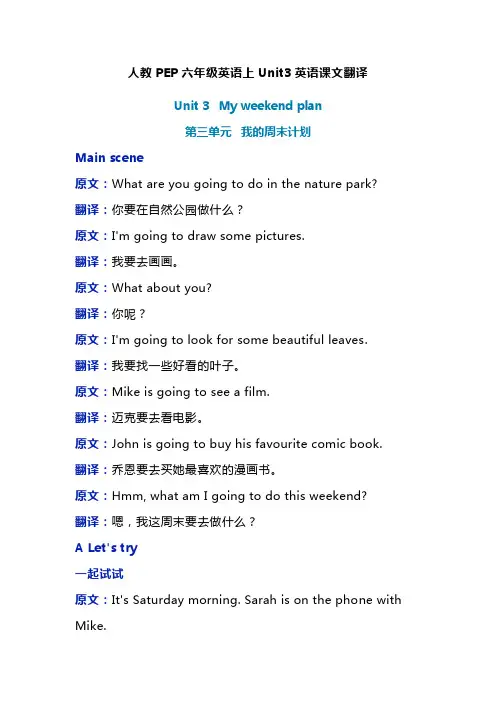
人教PEP六年级英语上Unit3英语课文翻译Unit 3 My weekend plan第三单元我的周末计划Main scene原文:What are you going to do in the nature park?翻译:你要在自然公园做什么?原文:I'm going to draw some pictures.翻译:我要去画画。
原文:What about you?翻译:你呢?原文:I'm going to look for some beautiful leaves.翻译:我要找一些好看的叶子。
原文:Mike is going to see a film.翻译:迈克要去看电影。
原文:John is going to buy his favourite comic book. 翻译:乔恩要去买她最喜欢的漫画书。
原文:Hmm, what am I going to do this weekend?翻译:嗯,我这周末要去做什么?A Let's try一起试试原文:It's Saturday morning. Sarah is on the phone with Mike.翻译:星期六早晨。
萨拉和迈克打电话。
Listen and circle.听并圈出。
原文:Hi, Sarah.翻译:你好,萨拉。
原文:Good morning, Mike.翻译:早安,迈克。
原文:Today is so warm. Let's go swimming.翻译:今天好暖和。
我们一起去游泳吧。
原文:Sorry, I can't. I have to do my homework now. 翻译:对不起,我不能。
我现在必须做作业。
原文:OK. What about this afternoon?翻译:好。
今天下午呢?原文:No, I can't. I'm going fishing.翻译:不行。
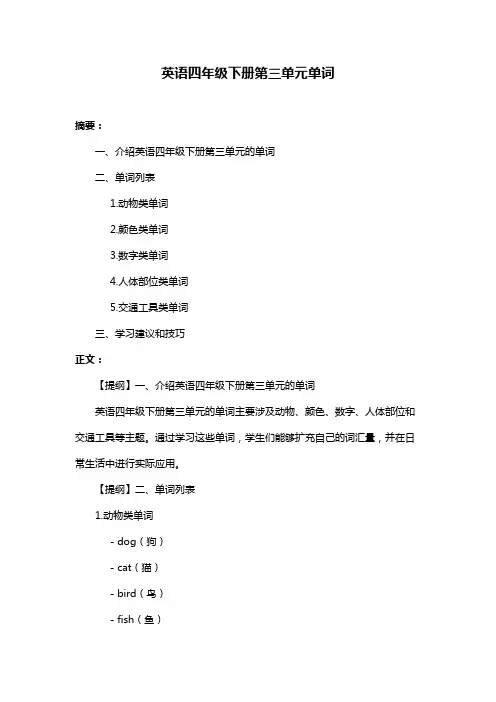
英语四年级下册第三单元单词摘要:一、介绍英语四年级下册第三单元的单词二、单词列表1.动物类单词2.颜色类单词3.数字类单词4.人体部位类单词5.交通工具类单词三、学习建议和技巧正文:【提纲】一、介绍英语四年级下册第三单元的单词英语四年级下册第三单元的单词主要涉及动物、颜色、数字、人体部位和交通工具等主题。
通过学习这些单词,学生们能够扩充自己的词汇量,并在日常生活中进行实际应用。
【提纲】二、单词列表1.动物类单词- dog(狗)- cat(猫)- bird(鸟)- fish(鱼)- rabbit(兔子)2.颜色类单词- red(红色)- blue(蓝色)- green(绿色)- yellow(黄色)- black(黑色)- white(白色)3.数字类单词- one(一)- two(二)- three(三)- four(四)- five(五)- six(六)4.人体部位类单词- head(头部)- eye(眼睛)- ear(耳朵)- nose(鼻子)- mouth(嘴巴)- arm(手臂)5.交通工具类单词- car(汽车)- bus(公共汽车)- train(火车)- bike(自行车)- boat(船)- plane(飞机)【提纲】三、学习建议和技巧为了更好地掌握这些单词,建议学生们多读、多写、多说、多练。
以下是一些学习建议和技巧:1.制定学习计划:每天学习一定数量的单词,并确保复习前面所学的内容。
2.创设语境:通过实际情境或场景来学习单词,增强记忆效果。
3.制作单词卡片:将单词写在卡片上,方便随时翻阅和复习。
4.拓展词汇:学习相关词汇,例如动词、形容词和副词等,形成词汇网络。
5.练习口语:与同学、老师和家人进行英语交流,提高口语表达能力。
6.参加英语角或英语活动:通过参加英语角或英语活动,增加实际运用英语的机会。
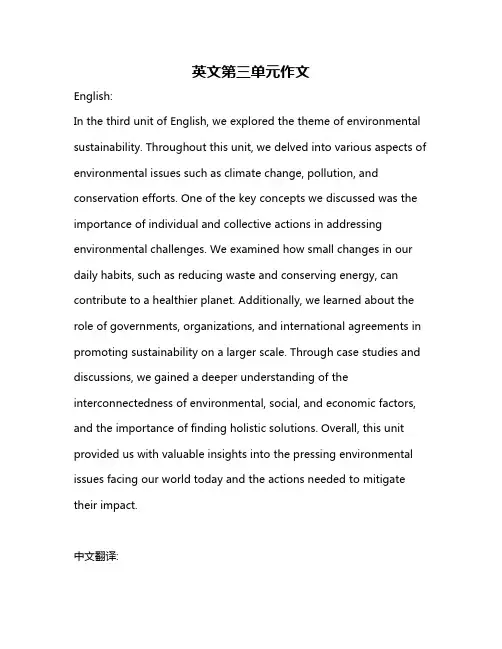
英文第三单元作文English:In the third unit of English, we explored the theme of environmental sustainability. Throughout this unit, we delved into various aspects of environmental issues such as climate change, pollution, and conservation efforts. One of the key concepts we discussed was the importance of individual and collective actions in addressing environmental challenges. We examined how small changes in our daily habits, such as reducing waste and conserving energy, can contribute to a healthier planet. Additionally, we learned about the role of governments, organizations, and international agreements in promoting sustainability on a larger scale. Through case studies and discussions, we gained a deeper understanding of the interconnectedness of environmental, social, and economic factors, and the importance of finding holistic solutions. Overall, this unit provided us with valuable insights into the pressing environmental issues facing our world today and the actions needed to mitigate their impact.中文翻译:在英语的第三单元中,我们探讨了环境可持续性的主题。
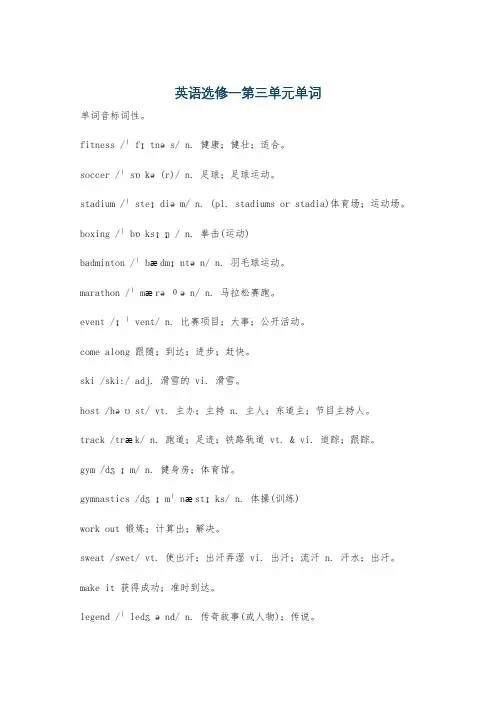
英语选修一第三单元单词单词音标词性。
fitness /ˈfɪtnəs/ n. 健康;健壮;适合。
soccer /ˈsɒkə(r)/ n. 足球;足球运动。
stadium /ˈsteɪdiəm/ n. (pl. stadiums or stadia)体育场;运动场。
boxing /ˈbɒksɪŋ/ n. 拳击(运动)badminton /ˈbædmɪntən/ n. 羽毛球运动。
marathon /ˈmærəθən/ n. 马拉松赛跑。
event /ɪˈvent/ n. 比赛项目;大事;公开活动。
come along 跟随;到达;进步;赶快。
ski /ski:/ adj. 滑雪的 vi. 滑雪。
host /həʊst/ vt. 主办;主持 n. 主人;东道主;节目主持人。
track /træk/ n. 跑道;足迹;铁路轨道 vt. & vi. 追踪;跟踪。
gym /dʒɪm/ n. 健身房;体育馆。
gymnastics /dʒɪmˈnæstɪks/ n. 体操(训练)work out 锻炼;计算出;解决。
sweat /swet/ vt. 使出汗;出汗弄湿 vi. 出汗;流汗 n. 汗水;出汗。
make it 获得成功;准时到达。
legend /ˈledʒənd/ n. 传奇故事(或人物);传说。
athlete /ˈæθli:t/ n. 运动员;运动健儿。
master /ˈmɑ:stə(r)/ n. 高手;主人 vt. 精通;掌握。
set an example 树立榜样。
honour /ˈɒnə(r)/ n. 荣誉;尊敬;荣幸。
glory /ˈglɔ:ri/ n. 荣誉;光荣;赞美。
medal /ˈmedl/ n. 奖章;勋章。
championship /ˈtʃæmpiənʃɪp/ n. 锦标赛;冠军赛;冠军称号。
captain /ˈkæptɪn/ n. (运动队)队长;船长;机长。
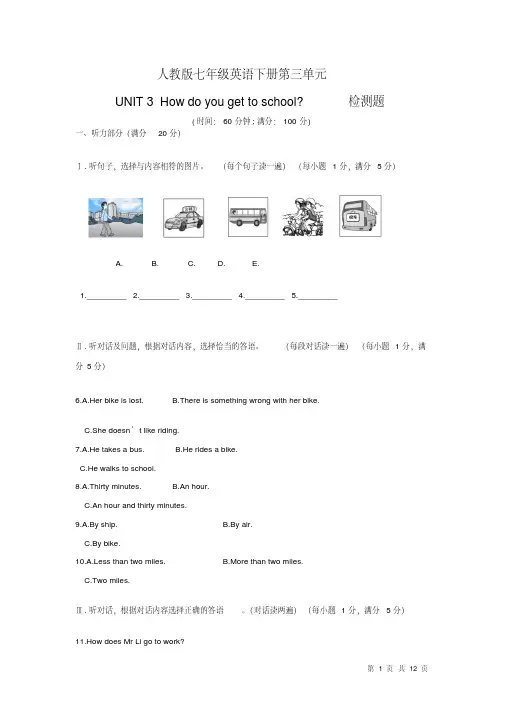
人教版七年级英语下册第三单元UNIT 3 How do you get to school? 检测题(时间:60分钟;满分:100分)一、听力部分(满分20分)Ⅰ.听句子,选择与内容相符的图片。
(每个句子读一遍)(每小题1分,满分5分)A. B. C. D. E.1._________2._________3._________4._________5._________Ⅱ.听对话及问题,根据对话内容,选择恰当的答语。
(每段对话读一遍)(每小题1分,满分5分)6.A.Her bike is lost. B.There is something wrong with her bike.C.She doesn’t like riding.7.A.He takes a bus. B.He rides a bike.C.He walks to school.8.A.Thirty minutes. B.An hour.C.An hour and thirty minutes.9.A.By ship. B.By air.C.By bike.10.A.Less than two miles. B.More than two miles.C.Two miles.Ⅲ.听对话,根据对话内容选择正确的答语。
(对话读两遍)(每小题1分,满分5分)11.How does Mr Li go to work?A.He goes to work by bus.B.He goes to work by boat.C.He goes to work on foot.12.How does Mr Li’s wife go to work?A.She goes to work by car.B.She goes to work by bus.C.She goes to work by boat.13.How does Mr Smith go to work?A.He goes to work by car.B.He goes to work by subway.C.He goes to work by boat.14.How does Mr Smith’s brother go to work?A.He goes to work by taxi.B.He goes to work by subway.C.He goes to work by motorbike.15.How does Tom go to work?A.He goes to work by bike.B.He goes to work by subway.C.He walks to work.Ⅳ.听短文,选择正确答案。
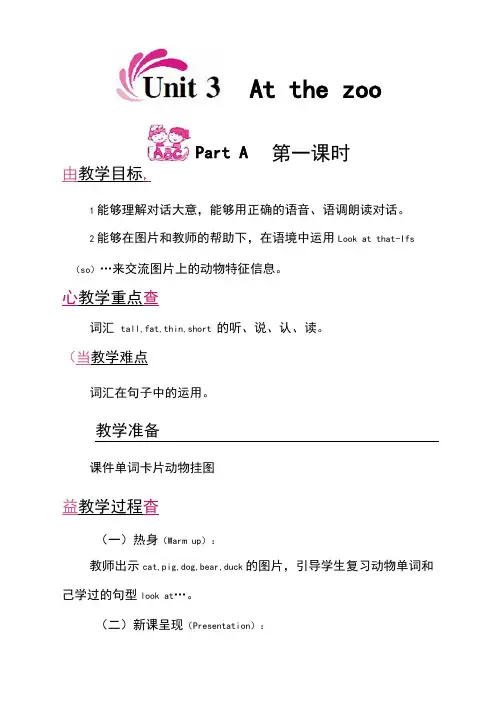
At the zooPart A 第一课时由教学目标,1能够理解对话大意,能够用正确的语音、语调朗读对话。
2能够在图片和教师的帮助下,在语境中运用Look at that-Ifs (so)…来交流图片上的动物特征信息。
心教学重点查词汇tall,fat,thin,short 的听、说、认、读。
(当教学难点词汇在句子中的运用。
教学准备课件单词卡片动物挂图益教学过程杳(一)热身(Warm up):教师出示cat,pig,dog,bear,duck的图片,引导学生复习动物单词和己学过的句型look at…。
(二)新课呈现(Presentation):1.教单词fat,tall,short以及句子It's so…。
(1)教师从黑板上取下pig的图片,教fatjfssofat.并用强调的语气和肢体语言强化so的意义。
(2)在教室墙上贴上giraffe的图片,先教单词再教句子Look at that giraffe.It*s so tallo(3)用panda的图片与giraffe的图片形成强烈对比,教句子It's short and fat.It's so tall.o2.两人小组游戏,轮流模仿学过的动物,用Is s so…来描述动物的特征。
3.播放对话录音两次,引导学生回答问题:Who is tall?Who is short and fat?4.让学生打开课本听对话,教师对语言点进行解释:Wow!表示惊叹,Ha!表示好笑。
教师培养学生热爱动物、保护动物的意识,提醒学生在动物园要遵守一定的行为规范,如不乱逗玩动物或不乱投喂动物等。
5.学生跟着录音读对话,然后进行角色扮演。
(三)巩固与拓展(Consolidation and extension):完成Draw and say。
教师先组织学生画出自己喜欢的动物,然后请几个学生上台展示并介绍:Look at my…IFs (so)…,并适当引导学生综合运用It likes… Ifs from…等学过的句子,之后组织两人小组活动。
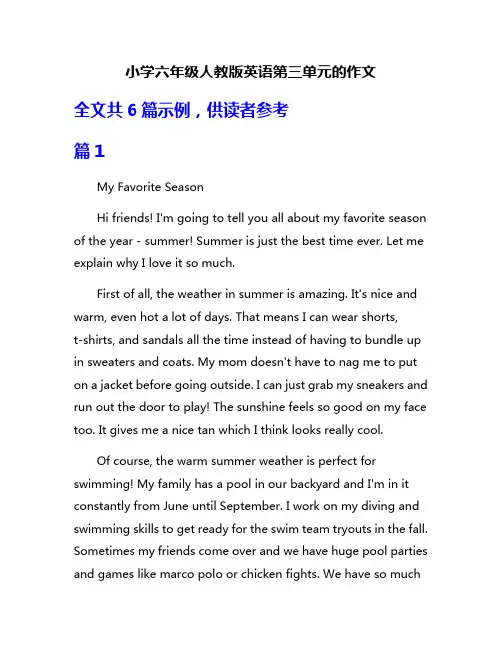
小学六年级人教版英语第三单元的作文全文共6篇示例,供读者参考篇1My Favorite SeasonHi friends! I'm going to tell you all about my favorite season of the year - summer! Summer is just the best time ever. Let me explain why I love it so much.First of all, the weather in summer is amazing. It's nice and warm, even hot a lot of days. That means I can wear shorts,t-shirts, and sandals all the time instead of having to bundle up in sweaters and coats. My mom doesn't have to nag me to put on a jacket before going outside. I can just grab my sneakers and run out the door to play! The sunshine feels so good on my face too. It gives me a nice tan which I think looks really cool.Of course, the warm summer weather is perfect for swimming! My family has a pool in our backyard and I'm in it constantly from June until September. I work on my diving and swimming skills to get ready for the swim team tryouts in the fall. Sometimes my friends come over and we have huge pool parties and games like marco polo or chicken fights. We have so muchfun splashing around and cooling off. When we get tired of the pool, we run through the sprinklers on the lawn to get soaked.Summer is also the best season for sports and being active outside. I love playing basketball, baseball, soccer, riding my bike, and just running around for hours without getting cold or having to take breaks to warm up. The park near my house has basketball courts, tennis courts, baseball diamonds, soccer fields and more that me and my friends use all summer long when it stays light really late. We get pretty sweaty from playing hard but it feels good. Then we walk over to the snack bar and buy frozen treats like ice cream sandwiches or banana splits to help us cool down.Speaking of food, summer has the absolute yummiest foods and snacks! My dad is the grill master in our house and he's always making hamburgers, hot dogs, steaks, and chicken breasts with veggie kabobs on the backyard grill. The charcoal smoke smells so good wafting through the neighborhood. And of course nothing beats a slice of cold, fresh watermelon on a blazing summer day. We have watermelon eating contests to see who can eat the most! There are also lots of fruits like cherries, peaches, plums, strawberries and more that just taste better when they're ripe and in season during the summer.For dessert, what beats a scoop of ice cream or two (or three!). We take lots of trips downtown in the summer evenings to the old-fashioned ice cream parlor that has about a million flavors, from classics like chocolate and vanilla to crazy ones like Superman (blue, red and yellow swirled together) and moose tracks (vanilla with peanut butter cups and fudge). I like to get a banana split piled super high with scoops of ice cream, whipped cream, cherries, nuts, and chocolate syrup. Yum!Another awesome part of summer is going on vacation! My family always takes a big trip every summer, although we don't know where until my dad surprises us at the last minute. One year we went to Los Angeles and saw movies being filmed, went on studio tours, and put our hands and feet in the celebrity handprints outside the Chinese Theater. Another summer we went camping and hiking in the Rocky Mountains, which was so beautiful with the tall peaks, wildflowers, waterfalls, and chance to see wildlife like elk, deer and even bears!Last year, we went to Hawaii and that was definitely my favorite trip so far. We snorkeled and saw tons of colorful fish, coral, and other marine life. We also went on a helicopter tour of the islands and saw incredible waterfalls and the tops of volcanoes. We spent a whole day at a luau eating kalua pork,lomi lomi salmon, haupia coconut pudding and more incredible Hawaiian foods while watching hula dancers and fire dances. It was absolutely amazing and I can't wait to see where we go on our summer trip this year!Finally, my favorite part about summer is that I don't have any school or homework to worry about! I can stay up really late since I don't have to get up early. I sleep in as late as I want most days. That means I also get to do my two favorite things as much as I want - play video games and watch TV/movies! I have so much free time in the summer to level up and beat tons of new games, from adventure and platformer games to sports, racing, fighting and more. I also get to binge-watch lots of new shows and movies, everything from comedies and action flicks to dramas and horror movies (when my parents aren't around!).As you can probably tell, summer is just the most fun time of year for a kid. No school, amazing weather, tons of activities and vacations, and basically just months of freedom, fun, and no responsibilities! That's why summer is 100% my favorite season and I can't wait until summer break starts again this year. I'm going to soak up every second before next fall when I'll be in 7th grade and back to the regular school routine. But until then -bring on the sun, swimming, sports, cook-outs, ice cream, movies and video games!篇2My Summer VacationWow, what a summer it has been! I had so many fun adventures and made lots of great memories. Let me tell you all about it!It started on the last day of school. I was so excited for summer to finally begin. No more waking up early, no more homework, just months of freedom and fun ahead. My parents promised we would go on a big trip this year since I did so well in my classes. I could hardly wait to find out where we were going!A few days later, they surprised me - we were going to New York City! I had never been before and it seemed like such an amazing, huge, bustling place. We packed our bags and before I knew it, we were on a plane headed to the Big Apple.When we arrived, I was in awe at the towering skyscrapers everywhere I looked. Our hotel was right in the heart of Manhattan, just blocks away from iconic sites like the Empire State Building, Central Park, and Times Square. That first night,we went out for huge, delicious slices of New York-style pizza. I had never tasted anything like it!The next day, we explored the wonders of the American Museum of Natural History. I felt like a real explorer, surrounded by dinosaur fossils, ancient artifacts, and the wonders of the plant and animal kingdoms. My favorite was the huge blue whale model hanging from the ceiling. In the afternoon, we wandered through the lush greenery of Central Park. We rented rowboats and paddled around the lake as families had picnics and kids played catch nearby. It was such a peaceful escape from the hustle and bustle just outside the park's borders.Another highlight was visiting the Statue of Liberty. We took a short ferry ride across the harbor for an up-close view of the iconic statue welcoming immigrants to America. Learning all about its history and symbolism gave me a newfound appreciation for this national treasure.Of course, no trip to NYC would be complete without seeing a spectacular Broadway show. We got dressed up and saw an amazing performance of Aladdin. The singing, dancing, special effects, and elaborate costumes blew me away. I left the theatre feeling totally enchanted.We spent a whole day at the Museum of Modern Art, or MoMA, admiring paintings, sculptures, and other contemporary artworks. I loved trying to interpret the deeper meanings and images each piece was expressing. My personal favorite was the famous painting of Campbell's Soup cans by Andy Warhol.Whenever we needed a break from museums and sights, we'd wander through unique neighborhoods like Greenwich Village, Chinatown, or Little Italy. The blend of cultures, architecture, and cuisine was endlessly fascinating. We had delicious dumplings, cupcakes, pizza, you name it!One morning, we rode sculls along the Hudson River for a unique view of the Manhattan skyline. Navigating those narrow boats took a ton of coordination, but I started getting the hang of it by the end. That night for dinner, we sat outside at a cafe and did some prime people-watching. So many interesting characters stroll by when you're in New York.On our final day in the city, we checked off one last must-see attraction - the Top of the Rock observation deck at Rockefeller Plaza. The 360-degree views overlooking Central Park and downtown skyscrapers were unbeatable. What a perfect way to wrap up an unforgettable week in the city that never sleeps!After returning home from our jam-packed NYC adventure, I thought I'd have time to relax and just veg out for the rest of summer. Boy, was I wrong! My days quickly filled up with a mix of sports, activities, camps, and hanging out with friends.In June, I went to soccer camp for two weeks. We had practices and drills each morning, learned about strategies and techniques, and then played matches against other teams in the afternoon. It was tough but I loved every second of it. My ball control and shooting really improved thanks to that intense training.My best friend Sam's family has a cabin up in the mountains, and I was invited to come along for a week of hiking, fishing, and campfires in July. We explored the wilds, kept our eyes peeled for wildlife like elk and bears, and cooled off in an ice-cold stream. Evenings were spent roasting s'mores and sharing scary stories under a canopy of stars. I felt so peaceful being surrounded by nature and away from the hustle and distractions of everyday life.In August, it was finally time for summer camp, which I look forward to every year. For two weeks, I was immersed in my favorite activities from swimming and archery to crafts and outdoor survival skills. I bonded with kids from all over whilemaking friendship bracelets, singing songs by the campfire, and challenging myself on the high ropes course. Summer camp is where I discover my courage, independence, and make memories to last a lifetime.When I returned home, school was just a couple weeks away, which meant scrambling to finish my summer reading and knocking out pesky assignments like writing about what I did for vacation. Well, you just got a 2000-word rundown on all my summer adventures! Between our amazing trip to New York, sleeping under the stars, adventures at camp, and staying active with soccer and other activities, it was summer well spent.While I'm definitely going to miss the free time and endless fun, I'm also excited to get back into the routine of school, see my friends every day, and start a fresh new year. After this taste of independence and making my own awesome summer memories, I know 6th grade is going to be a breeze. Goodbye summer, hello worlds of possibilities ahead!篇3Unit 3 - Having a PetHi everyone! My name is Xiaoming and I'm going to tell you all about Unit 3 in our 6th grade English textbook. This unit issuper interesting because it's all about having pets! I love animals, so I was really excited to learn more.The first part talks about different kinds of pets that people keep. The book has cool pictures of dogs, cats, rabbits, birds, fish and even some unusual pets like snakes and lizards! My favorite animals are dogs. I would love to have a cute puppy of my own one day. The book says dogs make great companions and that they are loyal and fun to play with. I agree completely!Next, we learned about how to take care of pets properly. This part is really important because pets are a big responsibility. You have to make sure to feed them the right food, give them fresh water, take them for walks if needed, and keep their living area clean. The book reminds us to never be cruel to animals. I would never want to hurt any animal!One spread had some funny pictures of kids getting licked by their dogs and cats knocking things over. It made the whole class laugh out loud! The book says that even though pets can be naughy sometimes, we should be patient with them. They don't mean any harm, they just act based on their natural instincts.There was also a really sad page about animals that get abandoned or lost. It made me feel terrible to read about homeless animals living on the streets without anyone to care forthem. The book tells us we should always adopted pets from animal shelters instead of pet stores. That way we can give a loving home to an animal in need. I hope I can do that when I'm older.One of my favorite activities was reading some fun poems about pets. One was about a cat who loved to take naps in the sun. Another was from the perspective of a dog who just wanted to play fetch all day long. I enjoyed using my imagination to understand how the animals might feel.We also learned how to describe our pets' appearance and personality in English. For example, we can say a pet is friendly, energetic, cuddly or mischievous. To describe how they look, you can talk about their fur color, eye color, size and any special markings. I practiced describing my grandma's cat, who is an orange tabby with green eyes.The final part was about taking our pets on vacation with us. The book showed different tips for traveling with animals, like bringing their favorite toys and not leaving them alone in hot cars. It seems like it would be fun but also a big challenge to go on a trip with a pet! You'd have to be very prepared.Overall, I really enjoyed learning about pets in Unit 3. My biggest takeaway is that owning a pet is a long-termcommitment that requires a lot of love, patience and responsibility. Pets give us so much joy and companionship, but we have to be willing to put in the effort to care for them properly too. After studying this unit, I feel ready to be an amazing pet owner someday!篇4My Summer Vacation Adventures!Hi everyone! I'm so excited to share all about my awesome summer vacation with you. I had such an amazing time and I can't wait to tell you all the fun details!The first big adventure of my summer happened right at the beginning of the break. My family and I went on a huge road trip! We loaded up the car with all our suitcases, snacks, games, and anything else we might need for the long drive. My little brother and I fought over who got to sit by the window at first, but then we made a schedule to trade off every few hours. That kept things fair.Our first stop was to visit my aunt, uncle, and cousins who live out in the countryside. Their house is on this huge piece of land with beautiful fields, a little stream running through it, and even a small barn with some animals! As soon as we arrived, mycousin Sarah took me out to meet the animals. They had chickens, goats, and the cutest little baby piglets! Sarah taught me how to gather the eggs from the chicken coop and feed the goats. I was a little nervous around the pigs at first because they were so big, but then I realized they were just friendly and wanted belly rubs.We spent three nights on the farm and I had a total blast. Every day we did something fun like fishing in the stream, picking berries to make jam, or hiking through the woods and looking for cool bugs and critters. One night we even had a big bonfire and roasted s'mores! I stuffed myself with so many of those gooey, chocolatey treats. Yum!After our farm adventure, we hit the road again and drove to the beach for a whole week of fun in the sun. We rented this cute little beach cottage right on the water. Every morning I could hear the waves lapping at the shore and the seagulls squawking overhead as I woke up. We spent our days swimming, boogie boarding, building sandcastles, and having picnics on the beach.I got a sweet tan and found so many cool shells to add to my collection.The highlight of our beach week was definitely going on a dolphin watching cruise! We went out on this big boat into theopen ocean and got to see dolphins swimming and jumping right beside us. The tour guide said we were lucky because we spotted a mom, dad, and baby dolphin swimming together as a little family pod. It was the most amazing thing I've ever seen. The baby dolphin was so tiny and kept doing these adorable little jumps out of the water. I'll never forget it!After our awesome week at the beach, we headed inland to go camping in the mountains for a few days. We pitched our tent in the middle of this beautiful forest beside a rushing stream. During the day we went on grueling hikes up the mountain trails to see waterfalls, meadows full of wildflowers, and breathtaking views from the peaks. The views were SO worth the hard climb! Everything was lush, green, and smelled like pine trees.At night in the campsite, we cooked our meals over the campfire, looked at the bright stars in the dark sky, and listened to the hoots of owls echoing through the trees. We could hear the stream babbling nearby which was such a peaceful sound for falling asleep to. I even saw a couple deer tiptoeing through the forest one evening! Camping was a little hard with having to use the smelly outhouse bathrooms and get kind of dirty, but it was still a super fun adventure.On our last few days of summer, we spent some time just relaxing around our neighborhood. I had playdates with my best friends and we went to the park, the pool, got ice cream and played video games at each other's houses. We made the most of the last few days of freedom before school started up again. Finally, the night before the first day of school, my mom made my favorite dinner and we did our traditional back-to-school shopping for new clothes and supplies. It was a bittersweet evening knowing the lazy days of summer were over, but I was also excited to start a new year!That pretty much sums up my amazing, adventurous,once-in-a-lifetime summer break! Between exploring the countryside, splashing in the ocean waves, hiking intense mountain trails, and squeezing in plenty of memory-making time with my best friends, it could not have been a better vacation. I have so many wonderful memories and experiences I'll never forget. Phew, I can't wait to get some rest before school starts tomorrow!What did you all do this summer? I hope you had adventures as awesome as mine! Let me know in the comments.篇5My Favorite SportsSports are really fun! I love playing sports and being active. My favorite sports are basketball, badminton, and running. I'm going to tell you all about why I like each one.Basketball is the best in my opinion. I've been playing basketball since I was in 3rd grade. At first, I wasn't very good. I couldn't dribble or shoot very well. But I kept practicing and now I'm one of the better players on my school team! What I love most about basketball is running up and down the court, dribbling the ball, and trying to score baskets. It's so exciting when you make a shot, especially if it's a 3-pointer from far away. Basketball really gets your heart pumping. You have to be quick, agile, and have stamina to play well. It's also a great team sport. You have to work together, pass to teammates, set screens, and play good defense. I love the feeling of my team working as one unit to beat the other team.My next favorite sport is badminton. Badminton is amazing because it's both physically and mentally challenging. Physically, you have to be able to quickly move side to side, lunging and jumping to hit the shuttlecock from different angles. Your reaction time has to be super fast. Mentally, you have to strategize and out-smart your opponent by hitting shots theywon't expect. You can smash it hard down the line or lift it high and soft to the back corner. There are so many different shot types and ways to win a point. I love the back and forth action, getting into crazy long rallies where we're both running all over the place. It's also fun because you can play badminton both seriously in competitions or just hit around for fun with friends. No matter how I play it, badminton always gets my heart racing and leaves me feeling accomplished.Finally, I love running because of how simple yet challenging it is. All you need are some good running shoes and you're set. Running lets me get outside, enjoy nature, and just put one foot in front of the other. It clears my mind and helps me de-stress. When I run I feel free, powerful, and like I can go anywhere. Of course, running is also very physically demanding, especially long distance runs. Your legs get tired, you get out of breath, and you have to push through pain and struggle. But that's whatmakes it so rewarding when you finally finish a long, tough run. I feel amazingly healthy and proud of myself. Running has taught me grit, endurance, and self-discipline. Whether I'm doing sprints, long distance, or just a relaxing jog, running will always be one of my top sports.Those are my three favorite sports - basketball, badminton, and running. Each one is special to me in its own way. They have helped make me stronger physically and mentally. They teach resilience, teamwork, strategy, and pur enjoyment of being active. As I get older, I hope I can keep playing and training in these sports. Exercising and being an athlete will allow me to stay healthy and fit throughout my whole life. Sometimes it's not easy to push myself, but the rewarding feelings I get from sports motivate me to keep going. Whatever I end up doing when I'm older, I know sports will always be a huge part of my life. Getting exercise and playing sports is just way too much fun to ever stop!篇6Unit 3 - My Busy WeekHi there! My name is Lily and I'm a 6th grader at Sunshine Elementary School. In our English class, we've been learning about daily routines and activities from Unit 3. It's been really fun and I've learned so many new words and phrases! Let me tell you all about my typical busy week.Monday is always the start of a new school week. I wake up at 6:30 am when my mom calls me. Getting out of my warm, cozy bed is definitely the hardest part of my day! After washing myface and brushing my teeth, I get dressed in my school uniform. For breakfast, I usually have some rice porridge with pickles and an egg. Yum!I take the school bus at 7:30 am to get to school on time for our first class at 8 am. The first two periods are always Chinese and math. Those classes are pretty hard but I try my best. At 10 am we get a short break time to play outside or eat a snack. My favorites are jianbing or tanghulu.After break, we have English class from 10:30 to 11:30 am. That's when we learn about fun topics like daily routines, hobbies, recipes, and more. I really enjoy English because we get to do lots of interactive activities like role plays, games, and songs. My English teacher, Miss Rose, is super nice and makes learning feel like playtime.The rest of the morning flies by with other classes like science, history, and PE. I get pretty hungry by noon so I'm always excited for lunch break at 12 pm. My school has a cafeteria with pretty good food. I usually get a tray with stir-fried vegetables, a meat or tofu dish, soup, and rice.After lunch, we have two more class periods from 1:30 to 3 pm. These afternoon classes cover subjects like art, music, andcomputer skills. Even though we work hard, the teachers like to mix in fun activities and games to keep us engaged.Once school ends at 3 pm, I hurry to join my afterschool activities which go until 5 pm. On Mondays, I take a traditional Chinese dance class. I've been learning dance since I was very little. It's my passion and I dream of becoming a professional dancer one day!By the time I get home around 5:30 pm, I'm exhausted from my long day. But there's still homework to do and chores to help my mom with. After dinner around 7 pm, I spend an hour or two on my homework for all my different classes. Before going to bed at 9 pm, I like to relax by reading, playing mobile games, or watching TV shows.Phew, Monday is definitely my busiest day of the week! The rest of the week follows a similar schedule, but with different afterschool activities each day. Tuesdays I have Chinese yo-yo class, Wednesdays is basketball practice, Thursdays is my art class, and Fridays is piano lessons.I look forward to the weekends when I can sleep in a little later and have more free time. But I still need to review what I learned during the week and prepare for the upcoming week.Saturday mornings I attend a math tutoring program and in the afternoons I work on my homework.Sundays are my favorite day because it's family time! In the mornings, my parents like to take me and my younger brother to the park for fresh air and exercise. We'll have a picnic lunch and then go to interesting places like museums, the zoo, or the movies. At night, we'll have a nice home-cooked dinner made by my mom and then we'll all watch the latest TV shows together as a family.Even though my weeks are extremely busy, I wouldn't have it any other way! Between school, extracurriculars, and family time, I'm constantly learning new things and exploring my interests. Sometimes it's stressful juggling everything, but I know it will all pay off in the end. My dream is to get into a top university and eventually have a career that I'm truly passionate about.Well, that's a typical week in my life as a busy 6th grader. I've got loads of energy and am making the most of this phase of life. Thanks for reading about my hectic but fun daily routines! I've got to run now and get started on this week's homework. Until next time!。
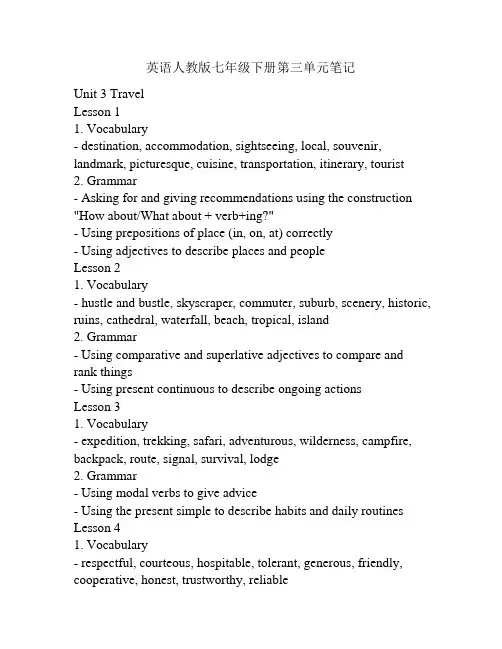
英语人教版七年级下册第三单元笔记 Unit 3 Travel Lesson 1 1. Vocabulary - destination, accommodation, sightseeing, local, souvenir, landmark, picturesque, cuisine, transportation, itinerary, tourist 2. Grammar - Asking for and giving recommendations using the construction "How about/What about + verb+ing?" - Using prepositions of place (in, on, at) correctly - Using adjectives to describe places and people Lesson 2 1. Vocabulary - hustle and bustle, skyscraper, commuter, suburb, scenery, historic, ruins, cathedral, waterfall, beach, tropical, island 2. Grammar - Using comparative and superlative adjectives to compare and rank things - Using present continuous to describe ongoing actions Lesson 3 1. Vocabulary - expedition, trekking, safari, adventurous, wilderness, campfire, backpack, route, signal, survival, lodge 2. Grammar - Using modal verbs to give advice - Using the present simple to describe habits and daily routines Lesson 4 1. Vocabulary - respectful, courteous, hospitable, tolerant, generous, friendly, cooperative, honest, trustworthy, reliable 2. Grammar - Using the present perfect to talk about experiences - Using phrasal verbs with "get" (get on, get off, get into, get out of) to describe transportation methods.
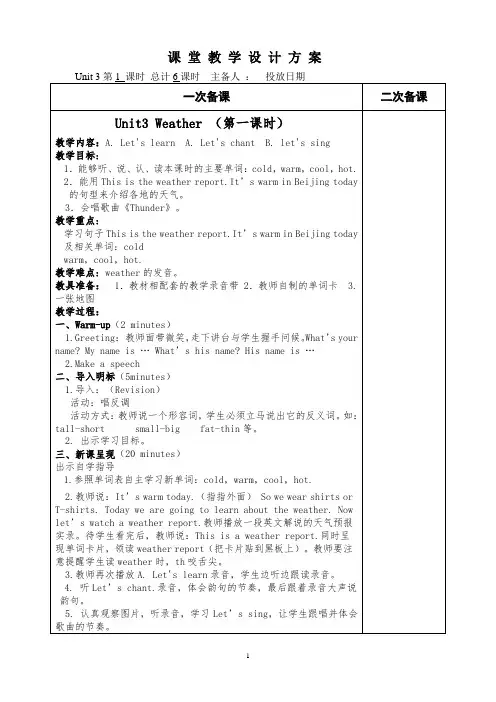
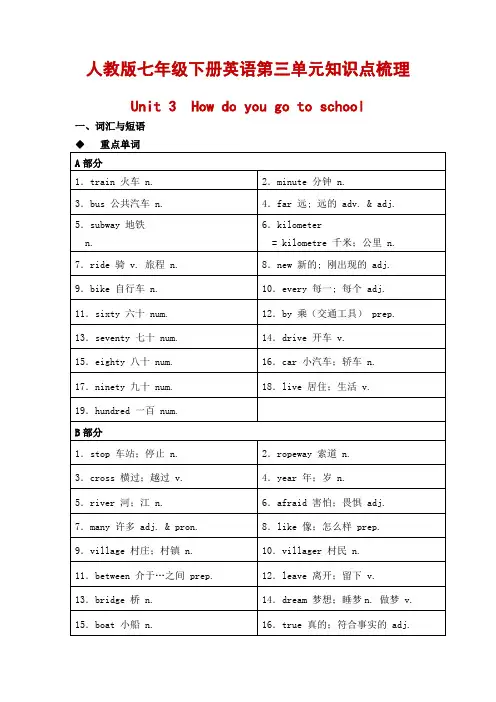
人教版七年级下册英语第三单元知识点梳理Unit 3 How do you go to school一、词汇与短语◆重点单词◆重点句子◆重点单词变形二、语法知识点A部分知识点1.与how构成的词组引导的特殊疑问句❶ how表示爱好、程度、看法等,意为“……怎么样?”。
eg:—How do you like the music?你觉得这首乐曲如何?—I like it very much.我非常喜欢它。
How is your Chinese?你的汉语如何?How do you like China?你认为中国怎么样?❷用于询问身体健康状况,意为“……怎么样?”。
eg:How do you do?你好!How are you?你(身体)好吗?❸ how提问交通方式。
其答语分三种情况:◆take a/the+表示交通工具的名词◆by +表示交通工具的单数名词◆on/in+限定词+表示交通工具的名词eg:How do you go to workevery day? 你每天怎样去上班?I take the subway to work. 我乘地铁去上班。
=I go to work by subway.=I go to work in the subway.❹表示感叹。
eg:How cold it is today!今天好冷啊!How hard they are working!他们在多么辛勤地劳动啊!How fast he runs!他跑得多快啊!❺表示某种方式、手段或方法。
eg:How do you spell it?你怎样拼写它?How did he go to schoolyesterday?他昨天是怎样去上学的?How do you know about it?你怎么知道这件事的?❻ how about用于询问或征询意见等,相当于what about,后接名词、代词或动词的-ing形式,意为“……怎么样?”。
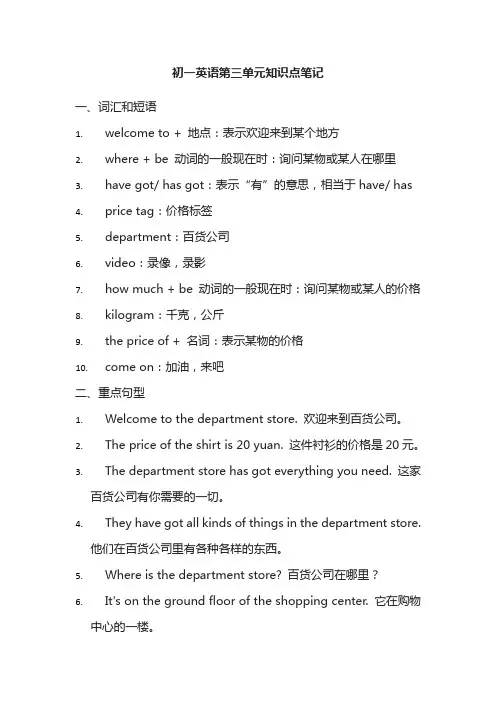
初一英语第三单元知识点笔记一、词汇和短语1.welcome to + 地点:表示欢迎来到某个地方2.where + be 动词的一般现在时:询问某物或某人在哪里3.have got/ has got:表示“有”的意思,相当于have/ has4.price tag:价格标签5.department:百货公司6.video:录像,录影7.how much + be 动词的一般现在时:询问某物或某人的价格8.kilogram:千克,公斤9.the price of + 名词:表示某物的价格e on:加油,来吧二、重点句型1.Welcome to the department store. 欢迎来到百货公司。
2.The price of the shirt is 20 yuan. 这件衬衫的价格是20元。
3.The department store has got everything you need. 这家百货公司有你需要的一切。
4.They have got all kinds of things in the department store.他们在百货公司里有各种各样的东西。
5.Where is the department store? 百货公司在哪里?6.It's on the ground floor of the shopping center. 它在购物中心的一楼。
7.How much is the blue shirt? 这件蓝色衬衫多少钱?8.It's 20 yuan a kilogram. 每公斤20元。
9.I want to buy a T-shirt for my son. 我想给我儿子买一件T恤衫。
10.Can you help me find the size for my son? 你能帮我找到适合我儿子的尺码吗?三、语法重点1.掌握“where + be 动词的一般现在时”的用法,用来询问某物或某人在哪里。
Unit 3 How do you get to school?一、必记单词train n.火车subway n.地铁ride v骑n旅程eighty num.八十ninety num.九十hundred num.一百minute n分钟far adv&adj.远:远de kilometer n千米;公里new adj新de;刚出现deevery adj每一;每个drive v.开车live v.居住;生活stop n.车站;停止cross v.横过;越过many adj.&pron.许多village n村庄;村镇between prep介于…之间bridge n.桥afraid adj害怕:惧怕villager n村民leave v.离开;留下dream n梦想;睡梦v.做梦true adj真de;符合事实de二、常考短语get to到达take the subway乘地铁ride a bike骑自行车every day每天by bike骑自行车think of认为;想起between….and….在….和….之间come true实现:成为现实get to school到达学校how far多远from home to school从家到学校take the bus乘公共汽车bus stop公共汽车站one 11-year-old boy一个11岁de男孩play with..和…玩be afraid害怕be like像……take..to…=go to.…by…乘……去How do/does.get to.?……怎样到达How far is it from.to.?从……到……有多远?It takes sb.some time to do sth.做某事花费某人多少时间。
How long does it take.?…花费多长时间?It is+adj+to do sth.做某事是…de。
三年级下册第三单元教案英语3篇三年级下册第三单元教案英语篇1My school bag教学目标:1. 能听懂、会说单词a tape, a pencil sharpener, a knife, a crayon2. 能听懂、会说、会读日常交际用语What’s this/that in/on the…? What’s this/that in English? It’s … Come here. 并获得运用所学语言进行交际的能力。
要求读音正确,语调自然。
重点难点:能正确理解运用介词in 和on。
教学过程用时:20分钟第一步:重难点突破用时:5分钟T: (PPT 1 显示课题) Hello, boys and girls. Nice to meet you.T: 同学们你们好,我是你们的新朋友,My name is May. 我的名字是May。
今天由我来和你们一起学习三年级第一单元Unit 1 My school bag,现在我们就开始吧!T: 首先我们来玩一个游戏复习已经学过的单词和句子。
请你看老师出示的图片,猜一猜它们都是些什么呢?(PPT 2)然后回答老师的问题What’s this?和What’s that? 你可以怎么回答呢?对了,你可以回答It’s a/an…记住了吗?好,我们开始吧!(PPT 显示图片剪影×4,教师带领学生问答)T: OK! Good! 你们回答的真好!现在老师要把几样东西分别放到不同的地方,请你仔细看好回答老师的问题 (PPT 3显示图片,若干物品分别放在桌子上椅子上盒子里面和上面。
)T: Look! What’s that on/in the …? (PPT 3点击显现物品)Yes. It’s a/an … (教授单词tape)T:同学们,刚才老师是怎么样用英语来问在某处的某样东西是什么的呢?你还记得吗?对了,老师是在原来我们学过的句子后面加上了物品所在的位置。
高中英语必修二第三单元重点、难点 Unit Three Computers 1、In pairs discuss what they have in common. 同桌讨论一下他们有什么共同之处。
common adj. & n. (1)共同的,常见的 You ’ve made a common mistake again. 你又犯了个常见错误。
(2)共同的;公用的 Parks are common property to the city’s people. 城市的公园是这个城市的人的公共财产。
联想扩展: have… in common 有共同之处 My son has nothing in common with me. 我儿子和我没有一点共同之处。
common ground 共同利益 common knowledge 人所共知的事 common sense 常识
易混辨析: common , usual , ordinary , average 普通,通常 common 所有人或事物所共有的,常见的,普通的。“习见习闻”。
usual 由过去的经验可判断为正常或通常,是按照预测发生的。
ordinary 与一般实物的标准、品德、习俗相同,平凡而不特殊,强调平淡无奇。
average 指达到平均水平,不突出。 即时活用: 用common , usual , ordinary , general填空。 1、This bird looks ______. 2、Anyone who has ______ sense can’t do it. 3、Lao Li came early as ______. 4、He is of the ______ height. 答案:1、ordinary 2、common 3、usual 4、average 2、I began as a calculating machine in France in 1642. 1642年我在法国诞生时是一台计算机器。
begin as 作为…开始;以…起步 The band began as a group of music lovers. 那个乐队一开始只是一群音乐爱好者。 The political leader began as a carpenter. 那位政治领导人是从一个木匠起步的。
联想扩展: begin at…从…开始 begin with 以…开始 to begin with 首先
3、After I was programmed by an operator who used cards with holes, I could “think” logically and produce an answer quicker than any person.
在操作员用穿孔卡为我设计程序之后,我能够进行逻辑“思考”,并且能够比任何人更快的算出答案。
produce vt. 用法归纳: (1)生产 That factory produces cars named Bi Yadi. 那个工厂生产比亚迪汽车。
(2)产;出 How many eggs did your hen produce this week? 你那只母鸡这个星期产了几个鸡蛋? That century produced many great men. 那个世纪出了许多伟人。
(3)引起;造成 Hard work produces success. 努力工作就能成功。 (4)演出;上演 They produced a new play last week. 上星期他们演了一部新戏。
(5)假装 He produced a smile on face when he saw me. 看到我时他脸上装出微笑。
联想扩展: producer n. 生产者 product n. 产品;产物 production n. 产量 productive adj. 多产的 4、As a result I totally changed my shape. 结果我完全改变了体型。
as a result 结果 As a result I lost my job. 结果我失去了工作。 联想扩展: as a result of.. 由于…的结果 As a result of the snow I came late for school. 由于下雪我上学迟到了。
特别提示: as a result 和as a result of..都用于引导状语从句。as a result 后不跟宾语,后面可以用逗号,也可以不用逗号;而as a result of..后必须跟宾语。
5、I was able to share my knowledge with others through the World Wide Web.
我能够通过万维网和其他人分享我的知识。 用法归纳: (1)分享;分担 Good friends should share both joys and sorrows. 好朋友应该分享快乐,分担痛苦。
(2)合用 The two economists shared the Nobel Economic Prize this year.
两位经济学家共同获得今年的诺贝尔经济学奖。 (3)共同具有 The two brothers share the same taste and interests. 兄弟俩品位相同,兴趣相同。
联想扩展: share还可以作名词。表示①一份东西 ②一份责任 ③ 股份 This is your share, please take it away. 这是你的那份,请拿走。
I have no share in that matter. 我与那件事情没关系。 I hold 1000 shares of that company. 我有那个公司1000股股份。
即时活用: 1、Good friends should______happiness and sorrows with each other.
A. spare B. share C. enjoy D. know 答案:B 2、Let Harry play with your toys as well , Clare---you must learn to _______ .
A. support B. care C. spare D. share 答案:D 6、Anyhow, my goal is to provide humans with a life of high quality.
不管怎么说,我的目标是为人类提供高品质的生活。 provide vt. & vi. 用法归纳: (1)提供 The trees provide shade. 树提供阴凉。 特别提示: 表示“给…提供…”用“provide sth. for sb.”。 Schools provide text-books for students. 学校为学生提供教科书。
(2)规定 School rules provide that students mustn’t smoke. 校规规定学生们不能吸烟。
联想扩展: provide against 预防 We all should provide against the spread of H1N1 flu. 我们都应该预防甲型流感的传播。
provide for 养活;做准备 He works day and night to provide for his family. 他不分昼夜的工作养活家人。
provide…with 给…提供 His firm is good and provides him with a car. 他的公司不错,给他提供了一辆车。
provided / providing conj. 如果…话;只要 Provided that it will snow tomorrow, we will put off the sports meeting.
如果明天下雪,我们就推迟运动会。 特别提示: provided和providing都用于作状语。provided多用于正式文体;providing多用于口语。
即时活用: 1、They live on their small farm ____ the family with corn. A. providing to B. provided C. providing D. provided to 答案:C 2、As we all know, two thirds of the earth’s surface is water, ___ a lot of fish.
A. provided B. providing C. which provides D. it provides